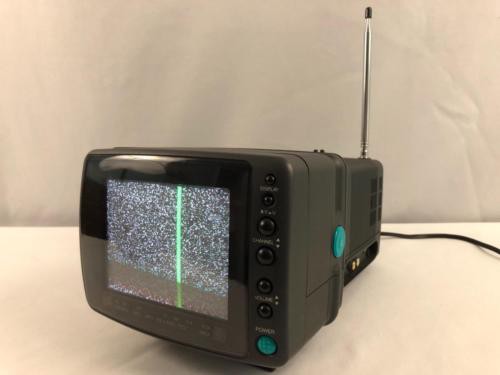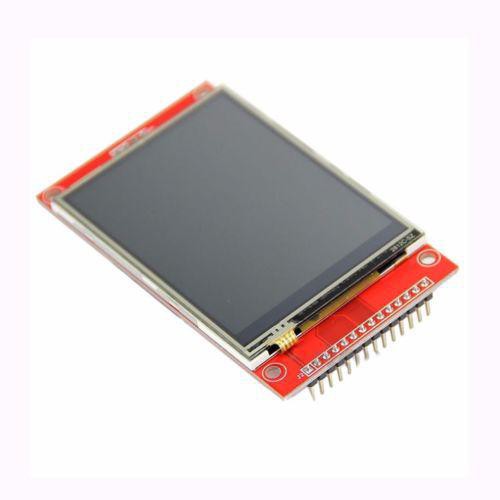The screen dimensions, for the 3 screens on the Voight Kampff, that I've finally decided on, which I based on advice from numerous others.... as well as what I could find in the correct aspect ratio of 4:3 (which is what was used at the time the movie was made). For the main screen, I'm using a color CRT screen with 5”diagonal (640x480 pixels with RCA video input), for the 2 smaller screens I'm using 2.4”diagonal LCD (320x240 pixels, with an SPI interface).
For the large, main, color screen:
I, finally, found a 5” diagonal color CRT screen
Magnavox portable
TV, model #RD0510 C102, manufactured August 1992 (about $26 US
,including shipping). This screen has 2 RCA plugs for input – 1
video and 1 audio. Video input works perfectly, audio I did not test since
I don't need it. The image below is from the eBay posting.

For the 2 smaller monitors (which I calculated to be 2.5” diagonal):
I settled on 2.4” LCD screens that take input though an SPI connection
2.4" SPI TFT LCD Display 2.4 Inch Touch Panel LCD ILI9341 240x320 5V/3.3V. ( Ideally I hoped to find some B&W CRT screens with a 2.5” diagonal).

Listing details from eBay were:
Description:
Size:2.4" SPI Serial
Display area:36.72(W)X48.96(H)mm
Driver element: a-Si TFT active matrix
Pixel arrangement: RGB vertical stripe
Driver IC: ILI9341
Backlight: White LED
Viewing Direction: 6 o?clock
Color Depth: 262K/65K
Resolution: 240RGB*320
5V compatible, use with 3.3V or 5V logic
Need at least 4 IOs from your MCU
With PCB plate (including power supply IC, SD), compatible with 5110 interface
$6.22 + $1.85 postage
Since, I don't need the touch screen on these I plan on removing them (they peel off fairly easily). Ideally it would be perfect to have B&W screens without touchscreen – but, due to supply and demand they are actually harder to find and more expensive.
At around this time last year (if memory serves me right) I tried using some similar LCD screens, only 2.8” diagonal and despite trying everything I could think of, including getting replacement screens, I could not get them to work, after about 2 weeks of trying (including getting replacements), so I I gave up and put them in my “Deep Fried Silicone” jar (assuming they must all be dead).
Recently, I acquired a Saelea logic analyzer clone and I thought “why not test the communication lines going to these screens from my old Arduino Uno R3 board to the LCD screens”... surprise, the D3 pin on my Arduino was not functioning. Lucky for me, this is an old board and the AVR chip is a DIP, instead of surface mount. So, I just pulled out the origonal ATMEL 328P and it out and plugged a new one in. Wallah... all the screens work perfectly now.
The 2.8” LCD screens, I ordered previously, were “Shield's” that mounted directly onto an Arduino Uno R3 board and used most of the pins on the board to control the screen. (Used parallel 8 bit communication)
The newer 2.4” LCD screens, I recently received, use fewer pins on the Arduino (configured for SPI, Serial Peripheral Communication) to interface with and control the screen. I have encountered a few unexpected issues... The most serious was the expectation that the screens worked at both 3.3v and 5v logic and power levels (they explicitly state “5V compatible, use with 3.3V or 5V logic”). It turns out this was not “exactly” true.
The “price” of inexpensive parts, frequently, seems to be a lack of documentation.
When I received my new LCD screens I was ready, my Arduino board already had an “example” sketch uploaded for SPI communication and wired to a solderless breadboard – just needed to plug in the screen and power everything up. Plugged the screen into the breadboard, connected the power supply, and … nothing happened.
Looking for schematics – figured that since these screens are Chinese knockoffs of open hardware, then multiple companies must be using the designs and at least one of them is likely to publish the specifications. As it turns out... I was right.
I'll show what I found in my next update (its getting to late and I need sleep).
 Tom Meehan
Tom Meehan
Discussions
Become a Hackaday.io Member
Create an account to leave a comment. Already have an account? Log In.